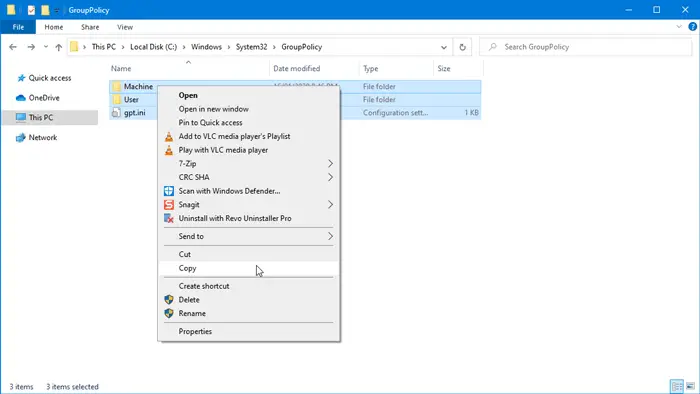If you are going to apply the same Group Policy settings on multiple computers, you can use the Export and Import feature. In this article, we will show you how to backup & restore, or import & export Group Policy settings in Windows 11/10.
The Local Group Policy Editor is a handy utility available on Windows Pro, Education, and Enterprise editions. This built-in tool allows you to tweak your system settings, create user restrictions, and do more. Now, let’s assume that you are installing Windows 11/10 fresh or need to install it on multiple machines, and you want to apply the same Group Policy settings on all of them.
You can use this procedure instead of opening the Local Group Policy Editor on each computer and making the changes manually. It will save you a lot of valuable time, and you do not need to go through all the options to find every setting you want to tweak. However, the problem starts when you try to find a direct option to back up the Group Policy Editor. Unlike the Registry Editor, there is no import/export option in Group Policy Editor. That is where this guide can help you.
Import or Export Group Policy settings in Windows 11/10

To backup/restore or import/export Group Policy settings in Windows 11/10, follow these steps-
- Open File Explorer on your source computer.
- Open the GroupPolicy sub-folder in the System32 folder.
- Copy all content and move it to the target computer.
- Paste all content in the same folder on the target computer.
- Force update the Group Policy or restart the computer.
Let’s delve into the steps to know more. You will need admin privileges to do this.
First of all, you should know that your Windows computer saves all the Group Policy changes into files and stores them in your hard drive. You need to move those files.
To get started, open File Explorer on your source computer and navigate to this folder:
C:\Windows\System32\GroupPolicy
Alternatively, you can open the Run prompt by pressing the Win+R, pasting this path, and hit the Enter button:
%SystemRoot%\System32\GroupPolicy\
You might need to show hidden files and folders to see the GroupPolicy sub-folder in the System32 folder.
Here you will find folders named Machine, User, gpt.ini, etc. A standard machine shows only these two folders, but there can be more if you made any special settings for a specific user.
You need to make a copy of these folders and all the content. Then, move them to the target PC, open the same GroupPolicy folder, and paste them respectively. If you get any Access denied prompt, you need to select the Do this for all current items checkbox and click the Continue button.
Now you need to force update the Group Policy or restart your PC.
Now you should find all the Group Policy changes on your target system.
Backup or Restore GPO using Windows PowerShell
You can also use the Backup-GPO cmdlet to backup one or all GPOs in a domain:
Backup-GPO [-Name] <string> -Path <string> [-Comment <string>] [-Domain <string>] [-Server <string>] [<CommonParameters>]
Backup-GPO -All -Path <string> [-Comment <string>] [-Domain <string>] [-Server <string>] [<CommonParameters>]
Backup-GPO -Guid <Guid> -Path <string> [-Comment <string>] [-Domain <string>] [-Server <string>] [<CommonParameters>]
You can also use the Restore-GPO cmdlet to backup one or all GPOs in a domain:
Restore-GPO -All -Path <string> [-Domain <string>] [-Server <string>] [-Confirm] [-WhatIf] [<CommonParameters>]
Restore-GPO -BackupId <Guid> -Path <string> [-Domain <string>] [-Server <string>] [-Confirm] [-WhatIf] [<CommonParameters>]
Restore-GPO -Guid <Guid> -Path <string> [-Domain <string>] [-Server <string>] [-Confirm] [-WhatIf] [<CommonParameters>]
Restore-GPO -Guid <Guid> -Path <string> [-Domain <string>] [-Server <string>] [-Confirm] [-WhatIf] [<CommonParameters>]
Restore-GPO [-Name] <Name> -Path <string> [-Domain <string>] [-Server <string>] [-Confirm] [-WhatIf] [<CommonParameters>]
The Restore-GPO cmdlet restores a GPO backup to the original domain from which it was saved. If the original domain is not available, or if the GPO no longer exists in the domain, the cmdlet fails.
Read next: How to reset Group Policy settings to default in Windows.
Leave a Reply